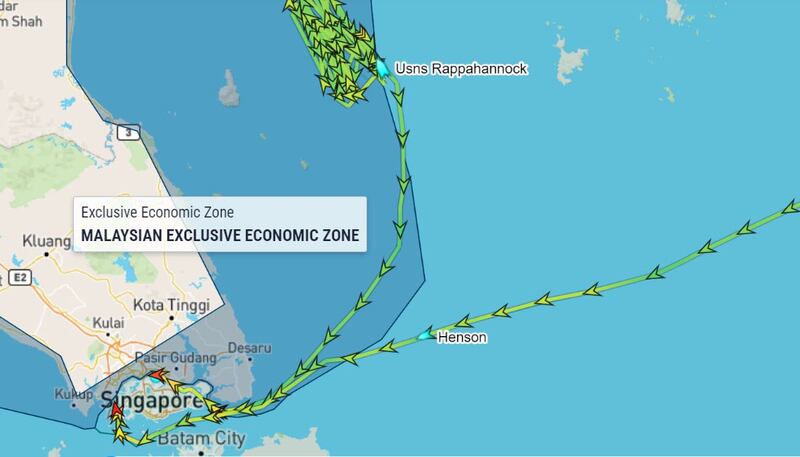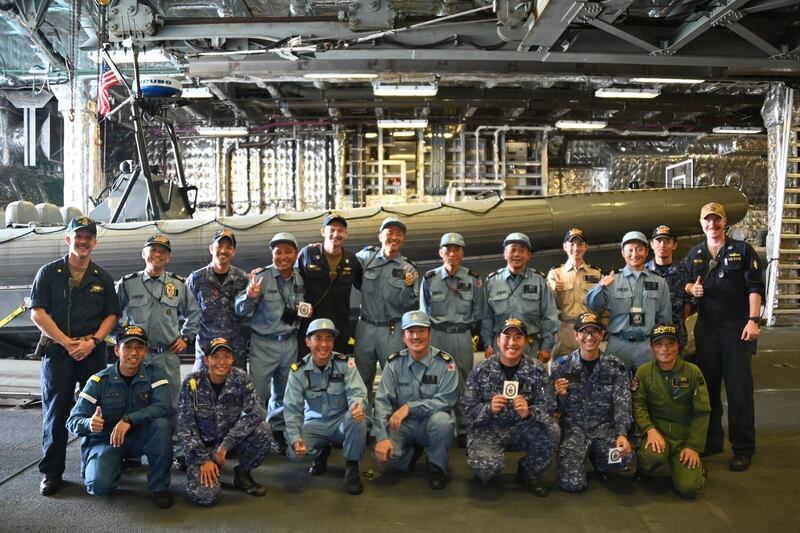UPDATED at 10:10 A.M. ET on 10-27-2023
Warships from the United States, Japan, Australia, Canada and New Zealand took part earlier this week in a multilateral exercise following a recent spat between China and the Philippines in the South China Sea.
Exercise Noble Caribou was held on Oct. 23 in the area between Indonesia and Malaysia "to improve our tactical capabilities and strengthen cooperation," Japan Maritime Self-Defense Force (JDMSF) said in a statement.
Participating vessels included Japan’s JS Akebono, the U.S. Navy’s USS Rafael Peralta, the Royal Australian Navy’s HMAS Brisbane, the Royal Canadian Navy’s HMCS Ottawa, and the Royal New Zealand Navy’s HMNZS Te Mana.
Ship-tracking data analyzed by Radio Free Asia also shows two other U.S. naval ships – the USNS Rappahannock and USNS Henson – were also operating nearby, adding to the impressive show of force.

A day earlier Manila summoned the Chinese ambassador to the Philippines over two incidents near the Second Thomas Shoal, in which Chinese coast guard ships were accused of “dangerously maneuvering,” causing collisions with Philippine ships.
China said Philippine vessels “trespassed” into its claimed waters.
“The participating countries in the exercise [Noble Caribou] are maritime nations with long coastlines in the Pacific Ocean, and are like-minded nations that seek to maintain an international order based on the rule of law in order to realize a Free and Open Indo-Pacific,” Commanding Officer of JS Akebono Togawa Hisato said.
“We believe that through this multilateral exercise, we were able to improve our tactical capabilities and strengthen cooperation with the navies of the participating countries, as well as embody their strong will and ability to create a security environment that does not tolerate unilateral changes to the status quo by force,” Togawa added.
The naval exercise “was likely planned long before the recent incidents but it is part of the US’s anti-China strategy,” said Mark Valencia, a senior research fellow at China’s Huayang Institute for Maritime Cooperation and Ocean Governance.
“Countries should show more restraint in their actions, particularly in their military displays of power,” Valencia told RFA, adding “I am not optimistic as this has become an ever deepening and spreading modus vivendi and will likely end badly.”
China’s position
The U.S. quickly spoke out in support of Manila over the incidents at the weekend, vowing to stand “with our Philippine allies in the face of the People’s Republic of China (PRC) Coast Guard and maritime militia’s dangerous and unlawful actions … in the South China Sea.”
Washington said Article IV of the 1951 U.S.-Philippines Mutual Defense Treaty “extends to armed attacks on Philippine armed forces, public vessels, and aircraft – including those of its Coast Guard.”
After the U.S. comments, France, South Korea, and Japan also voiced their support for the Philippines.

“In the South China Sea, China has actually exercised a lot of restraint,” said retired Chinese Senior Col. Zhou Bo, who now serves as a senior fellow of the Center for International Security and Strategy at Tsinghua University in Beijing.
“We have been too soft on the Filipinos,” Zhou told an international conference on the South China Sea in Ho Chi Minh City on Wednesday.
Chinese maritime experts have been critical of what they call “external forces” in South China Sea disputes.
Another Chinese analyst – Wu Shicun, president of China’s National Institute for South China Sea Studies – said at the same conference in Vietnam that the U.S. and U.S.-led security groupings all “clearly target China.”
“Removing the interference of external factors is the only way and only choice if we are to realize long-term peace and stability in the South China Sea,” Wu said.
Retired Senior Col. Zhou shares a more hawkish view that China is the only country that would “respond militarily to American provocations.”
“Probably China and the United States can only cool down after another collision at … sea or in the air, which I don't look forward to but there’s no other answer to this problem,” he said.
Edited by Mike Firn and Taejun Kang.
The story was updated to correct the spelling of the name of the U.S. Navy vessel USS Rafael Peralta.
